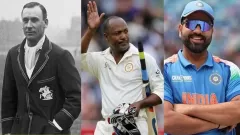Most Iconic Cricket Grounds in the world: Cricket is one of the oldest sports in the world and is steeped in tradition and heritage. Cricket is one of the most favorite sports in the world. It has many formats. t 20 and odi test which is played on many grounds domestic and international. But a select few grounds remain the most prestigious. So today we will tell about those iconic grounds.
10 Most Iconic Cricket Grounds in the world
| No | Ground Name | City | Country | Opened | Capacity |
|---|---|---|---|---|---|
| 1 | Antigua Recreation Ground | Antigua | West Indies | 1978 | 9,000 |
| 2 | Adelaide Oval | Adelaide | Australia | 1871 | 51,000 |
| 3 | The Gabba | Brisbane | Australia | 1895 | 42,000 |
| 4 | Melbourne Cricket Ground | Melbourne | Australia | 1853 | 100,024 |
| 5 | Sydney Cricket Ground | Syndey | Australia | 1848 | 48,000 |
| 6 | Kensington Oval | Bridgetown | Barbados | 1871 | 11,000 |
| 7 | Lord’s Cricket Ground | London | England | 1814 | 28,000 |
| 8 | The Oval | London | England | 1854 | 25,000 |
| 9 | Eden Gardens | Kolkata | India | 1864 | 68,000 |
| 10 | Himachal Pradesh Cricket Association Stadium | Dharamshala Kangra | India | 2003 | 23,000 |
| 10 | Wankhede Stadium | Mumbai | India | 1974 | 33,000 |
1. Antigua Recreation Ground, St. John(West Indies)

Opened: 1978
Capacity: 12,000
Situated on one of the most important ports of the West Indies, St. John's is famous for its 'hard and dry pitch' which favors the batsmen. Many of the most memorable moments of the Windies have happened at this ground. Viv Richards brings up his century in just 56 balls, a Test record, breaking Brian Lara's record 400 and the most successful run chase in cricket history. The ground has not hosted international cricket since 2009 but is known for its carnival-like atmosphere with live entertainment and classy pavilions. It has fallen into somewhat disrepair, but remains one of the most iconic venues in world cricket.
2. Adelaide Oval, Adelaide(Australia)

Opened: 1871
Capacity: 51,000
Scene for the annual Australia Day ODI match, the Adelaide Oval is a ground where modernity has embraced tradition to create a ground that is every bit the 21st century while maintaining its nearly 150 years of history. It will host the first Twenty20 International match between Australia and New Zealand as well as the first Day-Night Test match. The scoreboard has been in use since 1911 and the ground is believed to be the birthplace of English supporters club The Barmy Army.
3. The Gabba, Brisbane(Australia)

Opened: 1895
Capacity: 42,000
The Gabba is traditionally the first venue of an Ashes series hosted by the Australian team. It has long had the reputation of being a bad ground to play on. England have won only two matches there since 1945 and only seven Englishmen have passed the 100-run mark. Recent ground improvements have meant that it has lost its reputation as a battered ground and is now of a higher standard. But it is one of the strongest fortress of international cricket.
4. Melbourne Cricket Ground, Melbourne( Australia)

Opened: 1853
Capacity: 100,024
The MCG is not only the largest cricket ground in the world, but is also the first to host a Test match or ODI. It is the tallest light tower in international sports and hosts the annual Boxing Day Test - one of the biggest and most prestigious events in Australia's sporting calendar. With Christmas being the summer of the Southern Hemisphere, fans bring their leftover Christmas barbecues to watch the game's greatest players. As well as hosting World Cup finals in 1992 and 2015, it has seen its fair share of controversy, the most notable being the 1981 underarm bowling incident when Australia bowled underarm bowling to prevent New Zealand from hitting a last-ball six to win And umpire Darrell Hair awarded seven runs. Sri Lanka's Muttiah Muralitharan was no-balled in three overs for "chucking" – an incident that was to overshadow the spinner's illustrious career.
5. Sydney Cricket Ground( Australia)

Opened: 1848
Capacity: 48,000
Sydney is one of the most spin-friendly grounds in world cricket. Along with the MCG, it was one of the country's primary cricket venues and it was at this ground that New South Wales, the biggest contributor to the national team, played their games. have played It has served as the breeding ground for some of the game's best players including Sir Don Bradman and houses a picturesque traditional pavilion for members.
6. Kensington Oval, Bridgetown( Barbados)

Opened: 1871
Capacity: 11,000
Locally referred to as the "Mecca of Cricket" – the ground has hosted the 2007 World Cup final and the 2010 World Twenty20 final. The ground, which has been given a $45 million makeover for the 2007 World Cup, has a jacuzzi area and a large picnic area, has hosted several Test matches and has paid tribute to several legends of the West Indies game. The pavilion is named after Sir Garfield Sobers and is a stand for the three W's – Worrell, Weeks and Walcott.
6. Lord’s Cricket Ground, London( England)

Opened: 1814
Capacity: 28,000
It has hosted four World Cup finals as well as the traditional Gentlemen v Players match between amateurs and professionals as well as the Eton v Harrow game and many exciting matches have been played here. WG Grace, the great pioneer of cricket, is honored with a statue, and there is a famous Father Time weather pen. The famous Lord's Tavern was also on the site of the ground until 1961 and there is a cricket academy on the premises which has seen some of the beginnings of the English game.
7. The Oval, London( England)

Opened: 1854
Capacity: 25,000
The site of the first international and FA Cup final football matches, it also hosted the first Test of England and the last Test of the English summer. It is most famous for hosting the final match of the 2005 Ashes, which ended in a draw resulting in England winning the series. The 2005 Ashes was considered the toughest in many years, with both sides packed with world-class players. Televised in Britain on Channel 4, it was an event that rallied a nation in support of the team and the Test was arguably the greatest in the country's long cricketing history. The game has another iconic pavilion and just outside the ground is a set of iconic gasholders since 1853, although disused they have not been demolished, such is their aesthetic value to the ground.
8. Eden Gardens, Kolkata (India)

Opened: 1864
Capacity: 68,000
Cricket is like a religion in India. The nation is divided by language, religion, culture, class, caste but cricket has been a great unifier, especially since the 1983 World Cup victory. While in the early years of Indian cricket, it was a game associated with the educated middle class, it is now played by everyone and teams scour the inner-city urban jungles for the next big star. Eden Gardens is the largest ground in the country (an under-construction ground in Ahmedabad will overtake the MCG as the world's largest ground) and is a cauldron of noise and colour, creating one of the most passionate and exciting atmospheres in world cricket . It is also where Indian society is united in the love of sports, be it the Kolkata First Class team or the Knight Riders in the IPL.
9. Himachal Pradesh Cricket Association Stadium (India)

Opened: 2003
Capacity: 23,000
Built in the hometown of the Dalai Lama and against the backdrop of beautiful snow-capped mountains, the HPCA stadium contrasts the high octane of the IPL with peaceful calmness. Such is its grandeur, with its monastery-style pavilion and colorful seating, Kings XI Punjab plays occasional IPL matches and the ground has also started hosting international matches, with England coming for ODI.
10. Wankhede Stadium Mumbai (India)

Opened: 1974
Capacity: 33,000
Opened in 1974 following a dispute with Mumbai and the Cricket Club of India over ticket allocation at the Brabourne Stadium, the Wankhede has since become Mumbai's primary cricket venue. It is South India's answer to the Eden Gardens and over the years was the favorite playground of Sachin Tendulkar, India's greatest cricketer. Great cricketers like Gavaskar and Botham have played memorable innings at this ground and it played against Sri Lanka in the 2011 World Cup final. India's victory was hosted.


Disclaimer
Possible11 is a sports news and analysis platform designed purely for entertainment and educational purposes. All match previews, player insights, and team analyses are based on publicly available information and expert opinions. We do not promote or support betting, gambling, or real-money gaming in any form. Users are encouraged to enjoy our content responsibly and use it for informational purposes only.






























Give Your Feedback